The Skylake Core i3 (51W) CPU Review: i3-6320, i3-6300 and i3-6100 Tested
by Ian Cutress on August 8, 2016 9:00 AM ESTLegacy Benchmarks
Some of our legacy benchmarks have followed AnandTech for over a decade, showing how performance changes when the code bases stay the same in that period. Some of this software is still in common use today.
All of our benchmark results can also be found in our benchmark engine, Bench.
3D Particle Movement v1
3DPM is a self-penned benchmark, taking basic 3D movement algorithms used in Brownian Motion simulations and testing them for speed. High floating point performance, MHz and IPC wins in the single thread version, whereas the multithread version has to handle the threads and loves more cores. This is the original version, written in the style of a typical non-computer science student coding up an algorithm for their theoretical problem, and comes without any non-obvious optimizations not already performed by the compiler, such as false sharing.

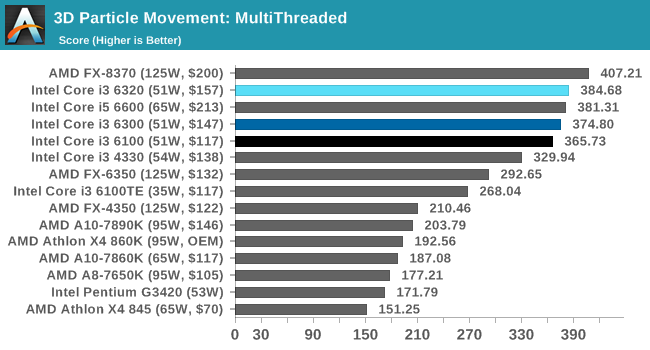
With un-trained programming skills comes a myriad of results. 3DPMv1 is not cache bound, but highly affected by false sharing and IPC. Our Core i3 staircase is in effect, and AMD is badly affected requiring 8 threads to match/beat an i3. In our v2 results, the spread is a more believable, which goes to show that having the right programming paradigm (even just a couple of lines of code) can make a large difference.
CineBench 11.5 and 10
Cinebench is a widely known benchmarking tool for measuring performance relative to MAXON's animation software Cinema 4D. Cinebench has been optimized over a decade and focuses on purely CPU horsepower, meaning if there is a discrepancy in pure throughput characteristics, Cinebench is likely to show that discrepancy. Arguably other software doesn't make use of all the tools available, so the real world relevance might purely be academic, but given our large database of data for Cinebench it seems difficult to ignore a small five minute test. We run the modern version 15 in this test, as well as the older 11.5 and 10 due to our back data.
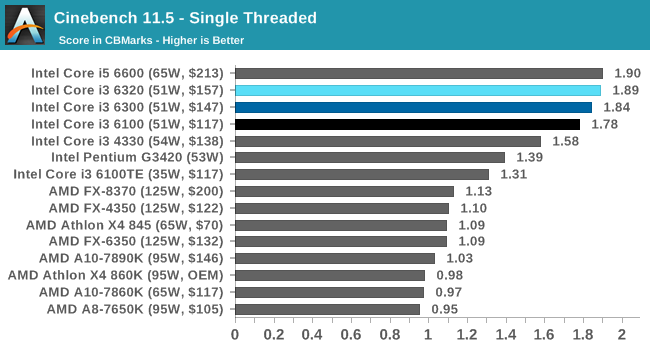
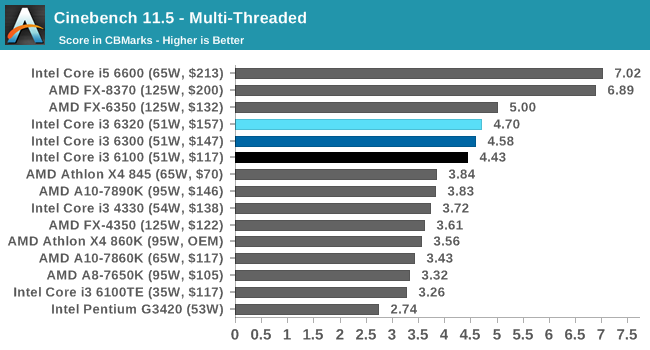
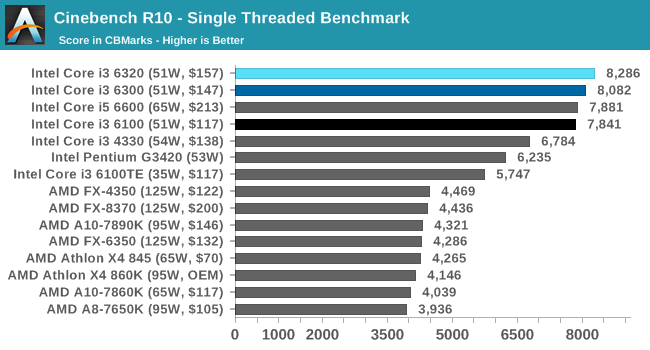

The older CB results mirror the CB15 test, albeit more compressed.
POV-Ray 3.7
POV-Ray is a common ray-tracing tool used to generate realistic looking scenes. We've used POV-Ray in its various guises over the years as a good benchmark for performance, as well as a tool on the march to ray-tracing limited immersive environments. We use the built-in multithreaded benchmark.
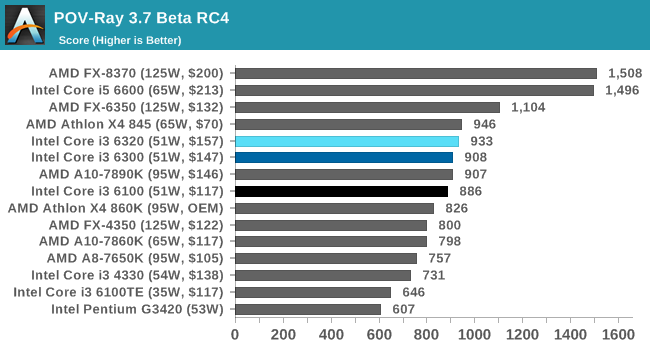
AMD gets a better showing in POV-Ray, with the $70 X4 845 going ahead of all of our Core i3 parts, and the older A10 sitting in between them. The older FX parts, despite their age, take advantage of the multi-threaded nature of the benchmark.
TrueCrypt 7.1
Before its discontinuation, TrueCrypt was a popular tool for WindowsXP to offer software encryption to a file system. The almost latest version, 7.1, is still widely used however the developers have stopped supporting it since the introduction of encrypted disk support in Windows 8/7/Vista from 5/2014, and as such any new security issues are unfixed.
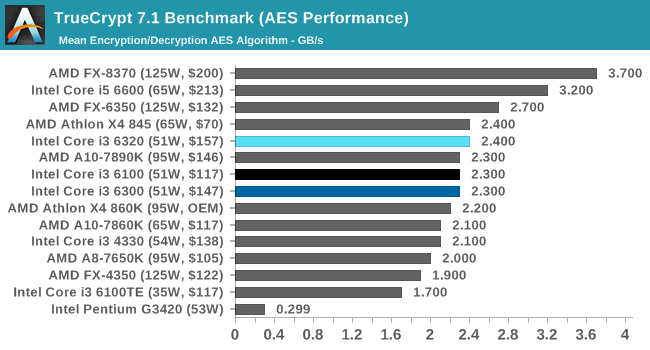
x264 HD 3.0
Similarly, the x264 HD 3.0 package we use here is also kept for historic regressional data. The latest version is 5.0.1, and encodes a 1080p video clip into a high quality x264 file. Version 3.0 only performs the same test on a 720p file, and in most circumstances the software performance hits its limit on high end processors, but still works well for mainstream and low-end. Also, this version only takes a few minutes, whereas the latest can take over 90 minutes to run.
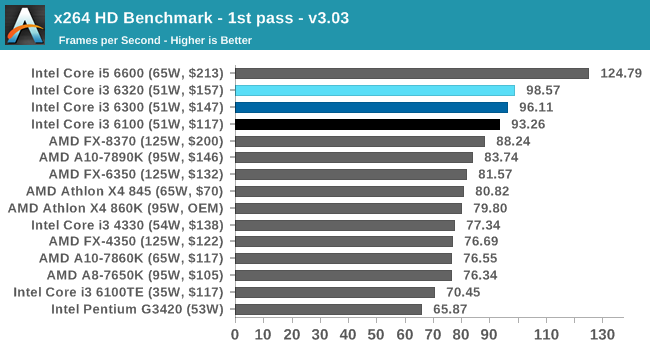
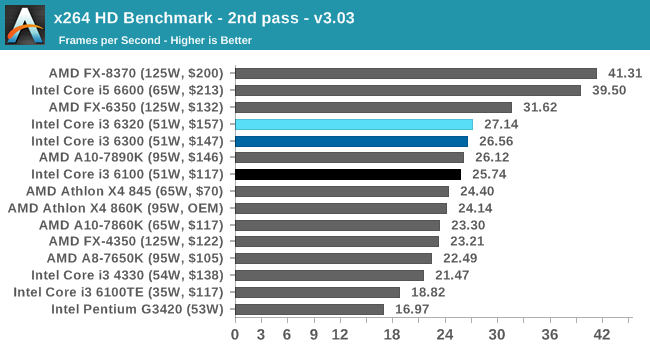
7-zip
7-Zip is a freeware compression/decompression tool that is widely deployed across the world. We run the included benchmark tool using a 50MB library and take the average of a set of fixed-time results.
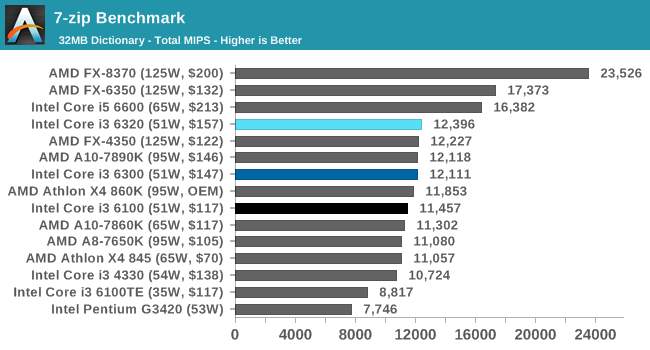










94 Comments
View All Comments
DonMiguel85 - Monday, August 8, 2016 - link
I remember in Eurogamer's i3-6100 review, just using 2666 or 3200MHz DDR4 gave a significant performance boost in pretty much all games, especially Ryse whose maximum FPS almost doubled from 59 to over 100FPS. And this was at the stock CPU clockspeed. Minimum frames improved substantially too.wintermute000 - Monday, August 8, 2016 - link
Problem is the price premium for 3200Mhz, you're already halfway to the cost of a dGPU like a GTX950 or R460 that will blow the doors off any iGPUwintermute000 - Monday, August 8, 2016 - link
whoops I guess I was looking at the expensive stuff, realised that not all 3200 is priced that much higherbeginner99 - Tuesday, August 9, 2016 - link
exactly. If you go Skylake, buy 3200 mhz RAM. For 16 GB it's only $20-30 more than 2133 mhz RAM and totally worth it.fanofanand - Monday, August 8, 2016 - link
Fantastic article Ian, you are definitely doing a great job of filling in the "lull" period between major GPU reviews. I have been wanting exactly this review to be done, as I would love to be able to build my kid a cheap computer for school that could do a bit of light gaming. I was really hoping the APUs would give adequate performance, but it looks like I will be waiting for Zen. I really don't want to get a dGPU for his computer and with Intel it doesn't look like there is much of a choice. Zen it is! Please don't disappoint us AMD!BrokenCrayons - Tuesday, August 9, 2016 - link
I'm keenly interested in seeing what Zen brings to the table too. However my next desktop PC upgrade is going to be a GPU of some sort and even that's probably a good 6+ months away if not more. Zen will be another CPU+Mobo+RAM swap and I'm not looking forward to anything of the sort right now...unless Zen can more than double the performance of my 860K, at which point I'll be very interested.Achaios - Monday, August 8, 2016 - link
Bought a brand new laptop today with an Intel Core i5-6200U Skylake onboard (which you have failed to include in your table) clocked at 2.3 GHz which turbos to 2.8 GHz.The thing I wanna say if you try to install Windows 7 on a Skylake machine without making a little in-depth research, you're screwed.
One way to install Windows 7 on Skylake machines is described by the following ASROCK article:
http://www.asrock.com/microsite/win7install/
(Thank you ASROCK).
I am not ashamed to say I spent the better part of day fighting off the dreaded "A required CD/DVD drive device driver is missing" before I had my Windows 7 Pro 64 Bit slipstreamed and updated by ASROCK's app.
Perhaps you should consider adding a couple of words on the subject as there are many ppl who will stay on Windows 7 for several years to come and are not very familiar with the Skylake platform.
DonMiguel85 - Monday, August 8, 2016 - link
Well, of course it's not on the table - that's a mobile chip. Plus unless you have some specific business need to use Windows 7 I don't see why you would go through the hassle of putting it on there. It's an almost 7 year old OS.fanofanand - Tuesday, August 9, 2016 - link
LOL "failed to include" I love it. "I bought it so you should review it, even if it's not even in the same segment as the other products you are reviewing". Classic snowflake narcissism.Meteor2 - Tuesday, August 9, 2016 - link
1. I wish you'd calculated price/performance and power/performance for us, rather than leaving us to guesstimate2. The game benchmarks need 95th (or whatever) percentile frame rates and minimum frame times, as that's where the performance difference between i3 and i5 truly lies.